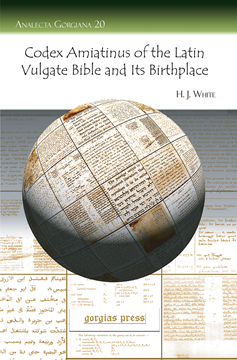The Books of the Bible and the Writings of Cyprian in the Phillipps Collection at Cheltenham
With a Stichometry by C. H. Turner
By W. Sanday
Series: Analecta Gorgiana 16
ISBN: 978-1-59333-494-9
The remarkable discovery of a fourth-century list of the books of the Old and New Testaments and the writings of Cyprian is related in this essay. The canon and order of the biblical books are discussed and the stichometry of the lists is also explored.
$90.00 (USD) $54.00 (USD)
The Authorship and the Titles of the Psalms According to Early Jewish Authorities
By Ad Neubauer
Series: Analecta Gorgiana 17
ISBN: 978-1-59333-495-6
Neubauer addresses the related issues of the authorship of the Psalms and the individual psalm titles according to the early Jewish authorities. Beginning with a survey of what is known about music usage in Israelite worship, Neubauer launches into a thorough examination of what the Rabbinic material preserves regarding these issues.
$46.00 (USD) $27.60 (USD)
The Origin and Mutual Relation of the Synoptic Gospels
By F. H. Woods
Series: Analecta Gorgiana 18
ISBN: 1-59333-496-6
The vexing question called the Synoptic Problem has long interested New Testament scholars. Woods weighs in on this question providing evidence for Mark’s priority based on the use of language in the Gospels.
$43.00 (USD) $25.80 (USD)
The Day and Year of Saint Polycarp’s Martyrdom
By C. H. Turner
Series: Analecta Gorgiana 19
ISBN: 1-59333-497-4
Among the most important chronological questions of Christianity in the second century is the date of St. Polycarp’s martyrdom. Turner scours the evidence to determine a precise date, based on comparison between the Roman and Asiatic calendars and other historical references. This dating in turn helps to date Irenaeus and St. John.
$44.00 (USD) $26.40 (USD)
Codex Amiatinus of the Latin Vulgate Bible and Its Birthplace
By H. J. White
Series: Analecta Gorgiana 20
ISBN: 1-59333-498-2
White takes the reader through a historical puzzle revolving around the date of the Vulgate manuscript Codex Amiatinus. He demonstrates that the manuscript falls in the eighth century and traces its origins to Italy.
$44.00 (USD) $26.40 (USD)
The Epistle of Eusebius to Carpianus
A Critical Edition of the Syriac Text with an Essay on the Ammonian Sections, Eusebian Canons, and Harmonizing Tables in the Syriac Gospels
Series: Analecta Gorgiana 21
ISBN: 1-59333-499-0
Gwilliam presents a critical edition of the letter of Eusebius to Carpianus, as well as a Latin translation. Essays concerning this important epistle addressing the harmonization of the Gospels provides a valuable early insight into the Synoptic Problem.
$45.00 (USD) $27.00 (USD)




